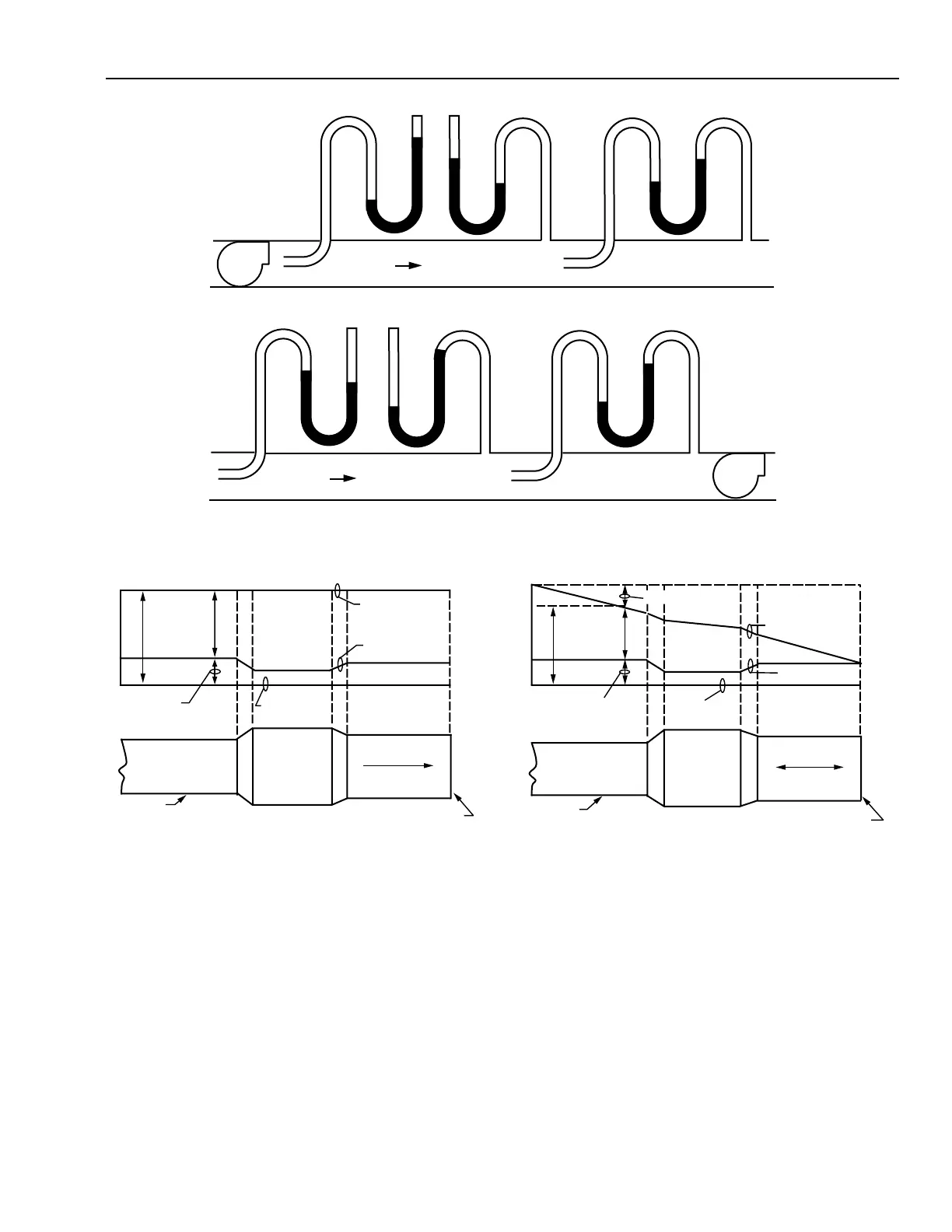ENGINEERING MANUAL OF AUTOMATIC CONTROL
BUILDING AIRFLOW SYSTEM CONTROL APPLICATIONS
275
TOTAL PRESSURE
STATIC PRESSURE
AIRFLOW
FAN
A. PRESSURE IN THIS DUCT ABOVE ATMOSPHERIC PRESSURE
TOTAL PRESSURE VELOCITY PRESSURE
B. PRESSURE IN THIS DUCT BELOW ATMOSPHERIC PRESSURE
C2643
AIRFLOW
FAN
STATIC PRESSURE
VELOCITY PRESSURE
Fig. 8. Relationships of Total, Static, and Velocity Pressures for Positive and Negative Duct Static Pressures.
In a theoretical duct system without friction losses, the total
pressure is constant along the entire duct (Fig. 9). The static and
velocity pressures, however, change with every change in the duct
cross-sectional area. Since the velocity decreases in larger duct
sections, the velocity pressure also decreases, but the static pressure
increases. When theoretical ducts change size, static pressure is
transformed into velocity pressure and vice versa.
An actual duct system (Fig. 10) encounters a phenomenon called
pressure loss or friction loss. Pressure loss is caused by friction
between the air and the duct wall. Dynamic losses also occur due
to air turbulence caused by duct transitions, elbows, tees, and other
fittings. At the open end of the duct in Figure 10, the static pressure
becomes zero while the velocity pressure depends solely on the
duct size. The pressure loss due to friction
TOTAL
PRESSURE
STATIC
PRESSURE
TOTAL PRESSURE
VELOCITY
PRESSURE
VELOCITY
PRESSURE
ATMOSPHERIC
PRESSURE
DIRECTION
OF AIRFLOW
AIR DUCT
OPEN END
OF DUCT
C2644
Fig. 9. Theoretical Changes in Pressure
with Changes in Duct Area.
appears to be a static pressure loss. However, in reality the total
pressure decreases because the pressure loss due to friction also
indirectly affects the air velocity in the duct. When the duct inlet
and outlet sizes are identical, the velocity pressures at both places
are equal and the difference in static pressure readings actually
represents the pressure loss due to friction.
In most applications, the duct outlet is larger than the duct inlet
(velocity is lower at the outlet than at the inlet). When the duct
size increases, a small part of the initial velocity pressure is
converted into static pressure and lost as friction loss (Fig. 11).
This concept is called static regain. Similar to water flow through
a pipe, a larger airflow through a given duct size causes a larger
pressure loss due to friction. This pressure drop or friction loss
cannot be regained or changed to static or velocity pressure.
TOTAL
PRESSURE
STATIC
PRESSURE
TOTAL PRESSURE
VELOCITY
PRESSURE
VELOCITY
PRESSURE
ATMOSPHERIC
PRESSURE
DIRECTION
OF AIRFLOW
AIR DUCT
OPEN END
OF DUCT
C2645
FRICTION LOSS
Fig. 10. Actual Changes in Pressure
with Changes in Duct Area.

